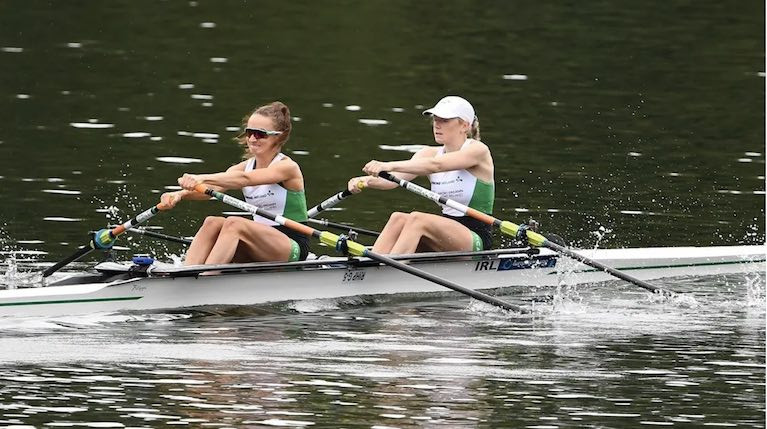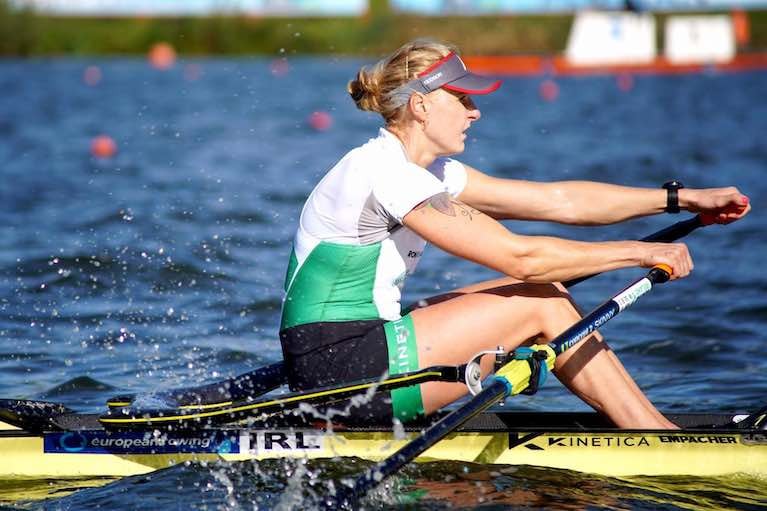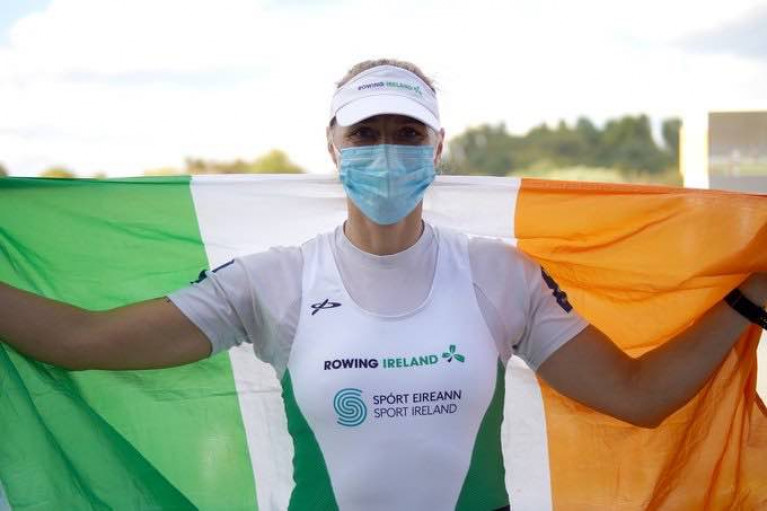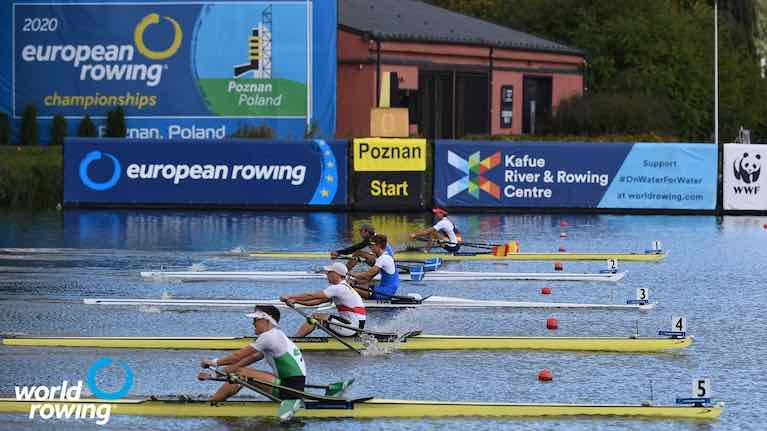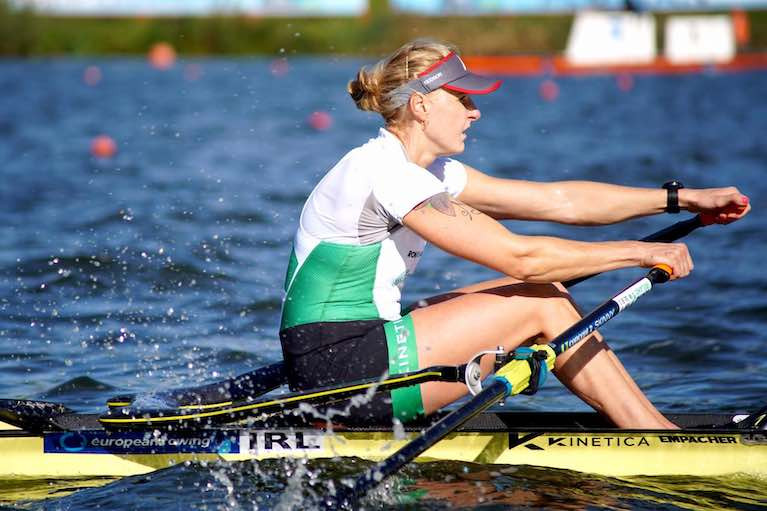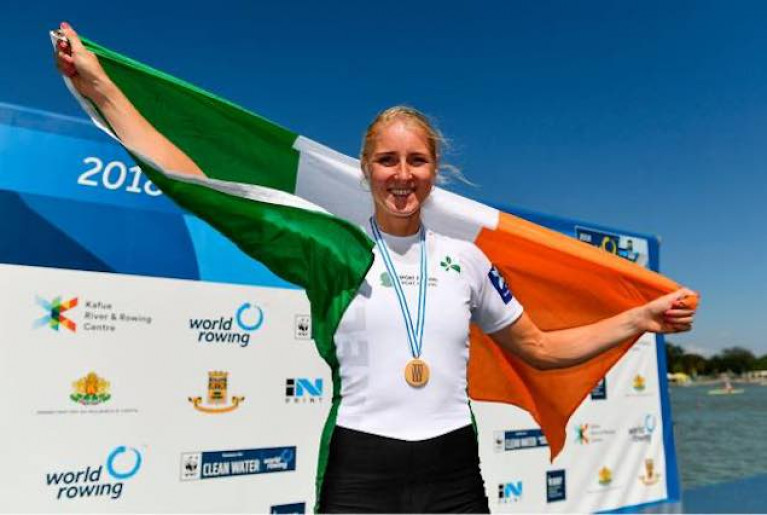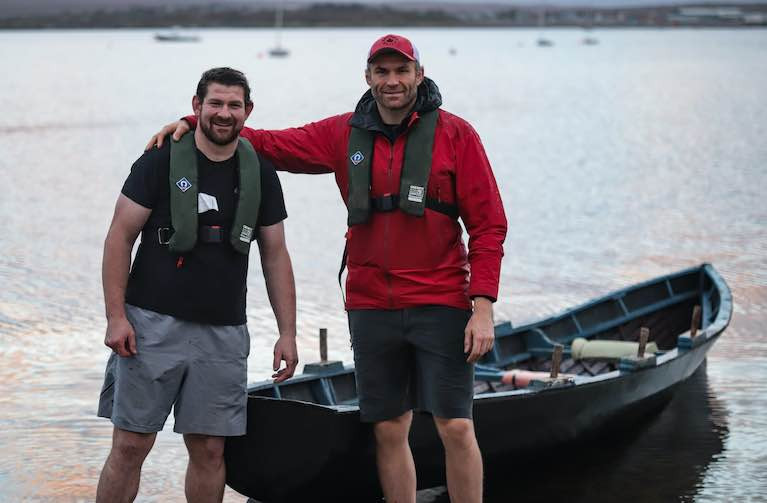Displaying items by tag: rowing
Dun Laoghaire Harbour Call in for Ireland-Iceland Rowing Boat Crew
A Greystones County Wicklow-based challenge to row from Ireland to Iceland next Spring made a preliminary call into Dun Laoghaire Harbour last week.
Led by James Murray, the expedition aims to "safely get from Ireland to Iceland under human power alone. No motors, no sails".
The schedule is to set off from Dublin, Ireland in Spring 2021 and for different crew members to join for legs on the way to Iceland.
As Murray explains on his website, row to iceland.com, "each team member has their own reasons for joining, but we all share an appreciation for the beauty of the places in-between and that seemingly extraordinary thing are possible".
Departing Dublin in April, the 3000km route will follow up Ireland's east coast before crossing to Scotland.
Following the Scottish coast, the plan is for the rowing boat to stop into fjords and towns along the way.
The plan then is to cross to the Orkney Islands and Shetland Islands before preparing for the big push to the Faroe Islands and then Iceland.
The trip is expected to take three to six months
Murray also asks on the campaign website that if you have experience with part of this route "we'd love to hear from you to help inform our plans".
Irish Olympic Rowing Has Four Crews Set to Compete in Tokyo 2021
Irish Olympic rowing is enjoying an all-time high with four crews already set to compete in Tokyo next year. The boats that have secured berths so far are the Women’s Single (W1X), Women’s Pair (W2-), Men’s Double Scull (M2X) and Men’s Lightweight Double Scull (LM2X). Note that the athletes will not be selected for these crews until closer to the Games, and competition is tight for all spots.
In rowing, there are just two opportunities to qualify for the Olympics – at the World Championships the year prior to the Games (2019), where the majority of spots are available. And also at the European Qualifier which take place two months before the Games.
Ironically, at the European qualifier crews from Australia, New Zealand, Canada and USA can also compete at this regatta (AUS, CAN and USA already have qualified), and for the Women’s Four there are just two spots available. Should they qualify, the crew that competes at the European Qualifier in Lucerne next May must remain the same for the Olympic Games.
There is also an outside chance that Ireland can qualify a Lightweight Women’s Double Scull (LW2X) at the same regatta. Note that this will be the last year that there will be lightweight events in rowing at the Olympic Games, a boat type that Ireland is historically successful at.
Meanwhile, the Olympic Federation spoke with Aifric Keogh from the Women’s Four (W4-), the Galway rower who is based in Cork at the National Rowing Centre. She spoke about what the World Championships Bronze medal has meant to her, and life in lockdown at the National Rowing Centre.
Rowing Ireland Qualifies Record Number of Boats for Tokyo Olympics
In an update from the Olympic Federation of Ireland, Rowing has qualified a record number of boats for the 2021 Olympics, with four boats heading to Tokyo, and still a good chance to get one or two more in the final qualification regatta before the Games.
The boats are:
Women’s Single Scull – Sanita Puspure finished first in the World Championships 2019
Men’s Lightweight Double Scull – Paul O’Donovan and Fintan McCarthy finished first in the World
Championships 2019
Men’s Double Scull – Philip Doyle and Ronan Byrne finished second in the World Championships 2019
Women’s Pair – Aileen Crowley and Monika Dukarska finished eleventh in the World Championships 2019
Rowing Ireland are still targeting two boats in the European qualifying regatta next year:
Women’s Four (W4-) there are two spots available.
Women’s Lightweight Double (LW2X) there are two spots available
Sanita Puspure Wins Gold at European Rowing Championships; Ireland Take Home Four Medals from Poznan
Sanita Puspure won the Gold medal in the Women’s Single Sculls and retained her European Rowing Championship title in Poznan today.
Seven Irish crews were competing in the final day at the 2020 European Rowing Championships. Five crews were competing in the A Finals and two boats competed in the B Finals.
The other Irish medal winners, Fintan McCarthy (LM1x), Ronan Byrne and Daire Lynch (MX2), Fiona Murtagh, Eimear Lambe, Aileen Crowley and Aifric Keogh (W4-) all won Bronze Medals in their A Finals.
A Final Results
Fintan McCarthy won Bronze in the Lightweight Men’s Single A Final. Fintan competed with crews from Norway, Italy, Greece, Hungary and Belgium. Kristoffer Brun from Norway took the Gold and Niels Torre from Italy finished second. Fintan finished third with a time of 07:02.150.
The W2- crew of Tara Hanlon and Emily Hegarty finished fifth in the A Final. The Irish pair were competing with crews from Romania, Spain, Greece, Denmark and Italy. The crew finished with a time of 07:28.280.
Ronan Byrne and Daire Lynch won Bronze in the A Final in the Men’s Double Sculls. The Irish crew competed against crews from Lithuania, Romania, Netherlands, Switzerland and Poland. Daire and Ronan finished third with a time of 06:41.210.
Aifric Keogh, Eimear Lambe, Aileen Crowley and Fiona Murtagh won Bronze in the Women’s Four A Final. The Women’s Four competed in their heat alongside boats from Denmark, Italy, Netherlands, Romania and Russia. The Irish Women’s Four finished third just behind the Italian crew with a time of 06:41.210 and just narrowly missed out on the Silver to the Swiss crew.
Sanita Puspure retained her European Championship by winning Gold in the Women’s Single Scull. Sanita won the race ahead of Magdalena Lobnig and Anneta Kyridou. Sanita was competing against crews from the Austria, Denmark, Germany, Greece and Switzerland. Sanita finished with a time of 07:36.040. Sanita is now a Double World and European Champion in the Women’s Single Scull.
B Final Results
Lydia Heaphy won the B Final in the Lightweight Women’s Single. Lydia beat crews from Germany, Hungary, Czech Republic and Slovenia on Sunday morning. Lydia finished the race with a time of 08:03.280.
The Lightweight Women’s Double of Margaret Cremen and Aoife Casey finished 2nd in the B Final. They competed against crews from the Switzerland, Greece, Denmark, Latvia and Spain and finished with a time of 07:18.780.
Rowing Ireland’s High-Performance Director, Antonio Maurogiovanni said ”I wish to congratulate all crews, coaches and support staff on the excellent performances and results at the European Rowing Championships. Winning four medals, One Gold and three bronze is a brilliant accomplishment for Irish Rowing this weekend. Out of our seven crews entered, five reached the A Final in their category, and two achieved excellent results in the B Finals.
These results have continued our success this year at U23 and Junior European Championships. We now have nine medals from three competitions at three different levels.
We are not considered the underdog anymore, and we all need to do better and push the bar higher to keep our current level of international competitiveness.
One of Rowing Ireland's High-Performance's ambition was to have a system able to offer to all our athletes the chance to be competitive in making finals and ultimately winning medals across all the categories including Senior, U23, Junior, Male, Female, Lightweight and Heavyweight. We are in the right direction, but a lot needs to be done.
I want to thank all of the athletes, coaches, support staff and clubs for all their continued hard work and dedication. A big thank you to all of the national coaches Dominic Casey, Giuseppe De Vita, Fran Kean, John Armstrong, Ciro Prisco. These results would not be possible if it wasn't for everyone working together as a team with passion and enthusiasm.
We are grateful to be able to compete in tournaments given the current health situation, and we thank World Rowing for organising this event. We now look forward to 2021 and the opportunity to qualify more boats for the Olympics next summer. "
Irish Final Results at European Rowing Championships
Lightweight Women’s Single Scull (LW1x) – 1st Place – B Final
Lightweight Women’s Double Sculls (LW2x) – 2nd Place – B Final
Lightweight Men’s Single Sculls (LM1x) – 3rd Place – A Final
Women’s Pair (W2-) – 5th Place – A Final
Men’s Double Scull (M2x) – 3rd Place – A Final
Women’s Four (W4-) – 3rd Place – A Final
Women’s Single Scull (W1x) – 1st Place – A Final
RTE Highlight Show
RTE will also be showing a highlight show on RTE2 tonight at 6:30 pm.
A Day Full of European Finals for Irish Rowing Team on Sunday!
The second day of the 2020 European Rowing Championships featured seven Irish crews racing in repechages and semi-finals, setting themselves up for a day full of finals tomorrow.
The first crew of the day were the W2- pair of Tara Hanlon and Emily Hegarty. The pair raced in their repechage with big competition from Belarus, the Netherlands and Denmark. Tara and Emily finished first with a time of 7:16.67 and will race in the A Final tomorrow.
Daire Lynch and Ronan Byrne started their day in the M2x Semi-Final. They faced competition from the Netherlands, Belgium and Serbia. Daire and Ronan finished third in their Semi-Final with a time of 6:21.66, securing their place in the A Final tomorrow.
Lydia Heaphy raced in the Lightweight Women’s Single Sculls (LW1x) repechage. She faced competition from the Russian and Polish crews and finished fourth with a time of 7:58.49. Lydia will race in the B Final tomorrow.
Fintan McCarthy raced in the Lightweight Men’s Single Sculls (LM1x) A/B Semi-Final. Fintan rowed in a tough race with crews from Italy, Belgium and the Czech Republic. Fintan finished second with a time of 6:57.10 and will race in the A Final tomorrow.
Margaret Cremen and Aoife Casey raced in the Lightweight Women’s Double Sculls (LW2x) Semi-Final. The pair faced competition from Italy, Belarus and Switzerland. Margaret and Aoife finished fifth with a time of 7:08.98. The pair will race in the B Final tomorrow.
The W4- crew of Aifric Keogh, Eimear Lambe, Aileen Crowley and Fiona Murtagh raced in the Women’s Four Repechage. The crew comfortably finished first with a time of 6:26.96. They will race in the A Final tomorrow.
Sanita Puspure raced in the Women's Single Sculls (W1x) Semi-Final to finish off the day. Sanita raced with the Austrian and Danish crews either side of her, with the three crews securing their places in the A Final tomorrow. Sanita finished second with a time of 7:37.84.
Sunday Races (IST)
Lightweight Women's Single Sculls (LW1x) Lydia Heaphy - B Final - 08:05
Lightweight Women's Double Sculls (LW2x) Margaret Cremen and Aoife Casey - B Final - 08:15
Lightweight Men's Single Sculls (LW1x) Fintan McCarthy - A Final - 09:31
Women's Pair (W2-) Tara Hanlon and Emily Hegarty - A Final - 10:46
Men's Double Sculls (M2x) Daire Lynch and Ronan Byrne - A Final - 11:31
Women's Four (W4-) Aifric Keogh, Eimear Lambe, Aileen Crowley and Fiona Murtagh - A Final - 11:46
Women's Single Sculls (W1x) Sanita Puspure - A Final - 13:31
Follow the rowing:
RTE TV Coverage
RTE will be covering the racing on the RTE Player tomorrow!
RTE will also be showing a highlight show on RTE2 on Sunday at 6:30 pm.
Sanita Puspure Advances to Women’s Single Scull A/B Semi-Finals at Euro Rowing Champs
Seven Irish crews were competing today at the 2020 European Rowing Championships. Four crews progressed to the A/B Semi-Final races on Saturday morning and three crews will race in the Repechage.
The W2-crew of Tara Hanlon and Emily Hegarty kicked off the Irish team’s racing this morning. The Irish pair were competing with crews from Russia, Italy, Greece and the Netherlands. The crew finished third with a time of 07:16.590. Tara and Emily will race in the Repechage.
Ronan Byrne and Daire Lynch competed in the Men’s double scull heat. The Irish crew competed against crews from Lithuania, Bulgaria, Slovakia, Finland and Serbia. Daire and Ronan finished second with a time of 06:22.020. Daire and Ronan have now progressed to the A/B Semi-Final on Saturday morning.
Lydia Heaphy raced in the Lightweight Women’s Single facing crews from Norway, Poland, Germany, Russia and Switzerland. Lydia finished sixth in her heat with a time of 08:01.550 and will race in the Repechage on Saturday morning.
Fintan McCarthy competed in the Lightweight Men’s Single, Fintan was competing with crews from Spain, Greece, Italy and Germany. Fintan finished third with a time of 07:05.980. Fintan moved into the Repechage later on Friday afternoon.
Fintan finished 1st in the Lightweight Men’s Repechage with a time of 07:07.35, Fintan will now compete in the A/B Semi-Final on Saturday.
The Women’s Four of Aifric Keogh, Eimear Lambe, Aileen Crowley and Fiona Murtagh competed in their heat alongside boats from Spain, France, Romania, Germany and Netherlands. The Irish Women’s Four finished second just behind the Netherlands crew with a time of 06:26.990. They will now race in the Repechage on Saturday morning.
Sanita Puspure raced in the Women’s Single Scull in Heat two. Sanita was competing against crews from the Netherlands, France, Serbia and Germany. Sanita finished second with a time of 07:35.510 and advanced to the A/B Semi-Finals on Saturday morning.
The Lightweight Women’s Double of Margaret Cremen and Aoife Casey finished 4th in their heat. They competed against crews from the Netherlands, Switzerland, Greece and Latvia and moved into the Repechage later on Friday afternoon.
Margaret and Aoife finished second in their Repechage with a time of 07:03.990. They will now compete in the A/B Semi-Final on Saturday.
Saturday European Rowing Races (IST) Irish interest
Women’s Pair (W2-) Tara Hanlon & Emily Hegarty – Repechage – 08:53
Men’s Double Scull (M2x) – Ronan Byrne & Daire Lynch – A/B Semi-Final – 09:13/09:18
Lightweight Women’s Single Scull (LW1x) – Lydia Heaphy – Repechage – 09:23
Lightweight Men’s Single Sculls (LM1x) – Fintan McCarthy – A/B Semi-Final – 09:33/09:38
Lightweight Women’s Double Sculls (LW2x) Margaret Cremen & Aoife Casey – A/B Semi-Final – 10:00/10:05
Women’s Four (W4-) Aifric Keogh, Eimear Lambe, Aileen Crowley and Fiona Murtagh – Repechage – 10:20
Women’s Single Scull (W1x) – Sanita Puspure – A/B Semi-Final – 10:45
Sanita Puspure To Defend European Rowing Crown in Poznan
This weekend senior Irish crews will be looking to continue the successes of the U23 and Junior crews who brought home six medals from their European Championships in September. Ireland will have seven crews competing at the European Rowing Championships in Poznan from the 9th -11th October.
Sanita Puspure will be defending her Championship after winning Gold at last year’s European Rowing Championships in Lucerne. In 2019, Sanita also won her second consecutive World Championship and qualified the Women’s Single Scull for the Olympics at the 2019 World Rowing Championships in Austria. After Sanita’s World and European Championships in 2019, she was named as the Irish Times/Sport Ireland Sportswoman of the Year.
Women’s Four
The crew of Fiona Murtagh, Aileen Crowley, Eimear Lambe and Aifric Keogh will be competing in the Women’s Four. Fiona has won the Head of Charles two years in a row and won at the Irish Rowing Championships. Aileen, alongside Monika Dukarska, qualified the Women’s Pair for the Olympics at the 2019 World Rowing Championships. Eimear has been competing internationally since 2015 and won Silver at the 2019 U23 World Rowing Championships. Aifric has been a member of the high-performance team for several years has won at the Irish Championships and set new World Records on the erg this year.
Fintan McCarthy will be competing in the Lightweight Men’s Single after a successful 2019. Fintan competed at the 2019 European Championships in Lucerne alongside his brother, Jake, in the Lightweight Men’s Double Sculls. Fintan then competed alongside Paul O’Donovan, winning Silver at the World Cup III in Rotterdam. Fintan and Paul went on to win Gold at the 2019 World Rowing Championship and qualify the Lightweight Men’s Double boat for the Olympics.
After a successful U23 European Championships, a number of our medal winners will be competing this weekend. Ronan Byrne and Daire Lynch look to continue their success after winning Gold in the Men’s Double at the U23 European Championships in September. In 2019, Ronan won Silver alongside Phil Doyle at the World Rowing Championships and the World Cup III; Ronan also won Gold in the Men’s Single at the 2019 U23 European Championships.
Margaret Cremen and Aoife Casey will be racing in the Lightweight Women’s Double in Poznan after winning the Silver Medal in the same category in Germany last month. Margaret and Aoife have competed together for several years and won Silver in this event at the Junior European Championships in 2017.
Lydia Heaphy will be competing in the Lightweight Women’s Scull, after winning Gold alongside Cliodhna Nolan in the Women’s Lightweight Pair last month. Lydia has experience competing in the Lightweight Single Scull having raced in the boat at the 2019 World Rowing Championships.
Tara Hanlon and Emily Hegarty won Bronze at last month’s U23 event, competing together in the Women’s Pair. Tara and Emily won Silver in the Women’s Four alongside Eimear Lambe and Claire Feerick at the 2019 U23 World Rowing Championships in Sarasota.
Irish Crews Competing
W1x
Sanita Puspure (OC)
M2x
Ronan Byrne (UCC)
Daire Lynch (Clonmel)
John Kearney (UCC)- Reserve
W4-
Fiona Murtagh (NUIG)
Aileen Crowley (OC)
Eimear Lambe (OC)
Aifric Keogh (UCC)
W2-
Tara Hanlon (UCC)
Emily Hegarty (UCC)
LM1x
Fintan McCarthy (Skibbereen)
LW2x
Margaret Cremen (UCC)
Aoife Casey (UCC)
LW1x
Lydia Heaphy (UCC)
New Support for Sport Initiative Launched By Texaco
Texaco has launched a support for sport initiative which sets aside a fund of €130,000 for distribution to sports clubs on a twenty-six, county-by-county basis, with successful applicants receiving €5,000 each.
At a time when many sports clubs may be experiencing financial strain, the initiative is one that Valero hopes will recognise the important contribution that sports clubs make to communities and throughout Irish society as a whole.
Open to sports clubs across the 26-counties of Ireland – irrespective of sporting discipline, size, membership, age, cultural appeal or gender – it is expected to attract all whose activities, goals and ambitions can, in the view of adjudicators, be materially advanced through the receipt and proper use of funding.
Speaking at the launch of the Texaco Support for Sport initiative, James Twohig, Director of Ireland Operations, Valero Energy (Ireland) Limited, described Irish sports clubs as a unifying element and a focal point for good in our communities. “In our cities, towns and villages, sports clubs are the magnets to which so many of us are drawn, homes-from-home where we meet and enjoy the friendship and camaraderie that sport offers and that all members and supporters share,” he said.
“By offering a new and innovative route to funding, we believe that the Texaco Support for Sport initiative will help uphold the unique values and characteristics that countless numbers of dedicated club members work so hard to preserve, whilst giving new expression to the cherished relationship that exists between the Texaco brand and generations of Irish sports enthusiasts,” James Twohig added.
Adjudication
Leading the adjudication process will be Texaco Support for Sport ambassador, acclaimed broadcaster and former Irish rugby international, Donncha O’Callaghan. “From my knowledge of sports clubs, gained at junior, senior and international level, I know how beneficial the Texaco Support for Sport initiative will be by bringing a much-needed benefit to clubs when it is least expected. Now more than ever, our clubs and volunteers need our support. I am really looking forward to reviewing the online applications, which provides clubs with the opportunity to showcase their importance to their local communities, and then seeing the recipients enjoy the benefit of this great initiative,” he added.
Application
Sports clubs can apply for funding from the Texaco Support for Sport from the 1 October 2020, the only requirement being that they be properly constituted and hold a valid Games & Sports Number (GS Number) issued by the Office of the Revenue Commissioners.
Those wishing to apply are invited to submit full details of their sporting activity, the purpose for which the funding is sought and the use to which it will be put. Full details of the scheme and its operation - together with registration, application, validation, adjudication and terms and conditions - are available to view at www.TexacoSupportforSport.com
Closing date for applications is the 31 December 2020 with adjudication taking place in January 2021.
Currach Crossing by Two Galway Rugby Players Planning Transatlantic Row
Two extraordinary men are set to row a currach from the Aran island of Inis Oírr to Galway city this morning to highlight their bid to cross the Atlantic in 2022.
Extreme adventurer and former professional rugby player Damian Browne and his lifelong friend Fergus Farrell aim to set a new Guinness world record in an unsupported row some 4,937km across the Atlantic in two years’ time.
Weather permitting, their 40 km (25-mile) row today (Tues 27th) launches the project’s crowdfunding campaign and symbolises the last leg of their Atlantic traverse.
The two men from Renmore, Galway city, and Athenry, Co Galway respectively have been friends and rugby players with Connacht and Galwegians Rugby Football Club since they were young.
Two years ago, Farrell became paralysed after a workplace accident and was diagnosed with a serious spinal cord injury.
After treatment in the National Rehabilitation Hospital (NRH) in Dun Laoghaire, Co Dublin, he walked 206 km from the place of his accident to the NRH.
Farrell raised 70,000 euro in his “Toughest Trek” for the hospital in late October, 2019.
Browne has completed the six day, 257km-long Marathon des Sables across the Sahara Desert - also known as “The Toughest Footrace on Earth” - and successfully rowed across the Atlantic solo in late 2017-early 2018.
One of just 60 people to complete the crossing alone, he endured nine-metre high swells, deep lacerations on his head, and a complete steering system failure. His boat capsized in a storm and was almost destroyed by an oncoming cargo ship.
He had lost 28 kilos when he completed the crossing in 63 days, 6 hours and 25 minutes. Browne is also multi-time Irish indoor rowing champion and currently holds the all-time records for the 500m and 1000m distances.
To date, he has raised over €100,000 for Irish and African based charities through his extreme adventures and is a founder and leader of Freezbrury, an international group challenge held annually every February .
He has also climbed five of the seven summits or highest peaks on each continent, and aims to tackle Everest in April/May 2021.
The record for an Atlantic crossing from New York to the Scilly isles still stands since set by George Harboe and Frank Samuelsen in 1896 - taking 55 days and 13 hours.
They had no water makers or satellite phones, GPS, emergency position indicating radio beacons ( EPIRBs) or even a life raft on board, Browne and Farrell note.
Some 11 pairs have attempted to better it, but failed, with six of the 11 completing the crossing.
There have been 52 previous attempted crossings in an unsupported row, with 18 successfully making land in some part of Europe.
Browne and Farrell have initiated Project Empower, which they describe as a “24-month studied endeavour in human empowerment”.
Their ocean rowing boat will be built by master builder Justin Adkin of Seasabre, who also constructed Browne’s vessel for his transatlantic row. The craft will be a “classic design”.
Rowing Ireland Announces David McGowan's Resignation as High-Performance Coach
Rowing Ireland has issued a statement confirming that David McGowan has resigned from his position as High-Performance Coach effective immediately, due to personal reasons.
David took up the position in 2018.
Speaking of his departure, David Mc Gowan said “I would like to thank the whole Rowing Ireland family for their support throughout my coaching time. I was made welcome by the people of Ireland and the family of rowers. Thank you to the athletes, parents and all those who work so hard behind the scenes to support this small rowing organisation to fight well above its weight. The team at Rowing Ireland have become my family and friends over the last three years, and I wish Antonio, the athletes and crews every success in these challenging times”.
Rowing Ireland’s High-Performance Director, Antonio Maurogiovanni said “David has coached, inspired and supported our athletes to deliver their best results. He has the vision and worked tirelessly to achieve it, culminating in our success at the 2018 and 2019 World Championships. He has been my colleague and my friend, and we will hugely miss him as part of the team”.






























